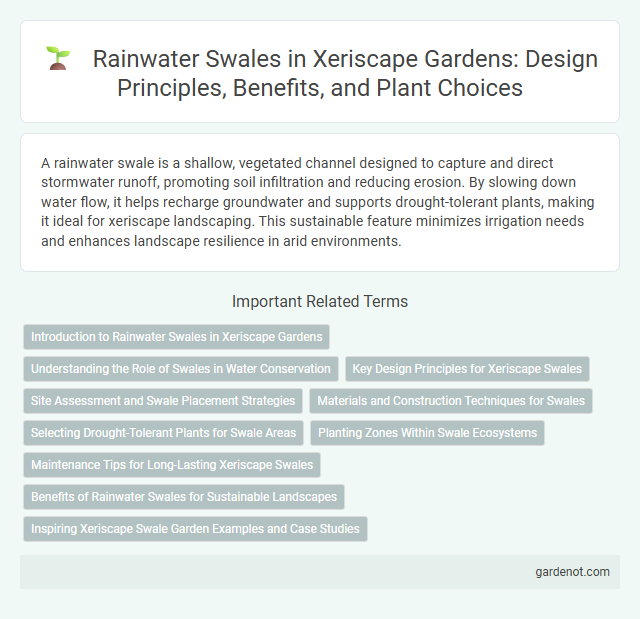A rainwater swale is a shallow, vegetated channel designed to capture and direct stormwater runoff, promoting soil infiltration and reducing erosion. By slowing down water flow, it helps recharge groundwater and supports drought-tolerant plants, making it ideal for xeriscape landscaping. This sustainable feature minimizes irrigation needs and enhances landscape resilience in arid environments.
Introduction to Rainwater Swales in Xeriscape Gardens
Rainwater swales are shallow, vegetated channels designed to capture and infiltrate stormwater runoff in xeriscape gardens, enhancing water conservation and reducing erosion. These landscape features promote groundwater recharge by directing rainwater slowly through permeable soil, supporting drought-tolerant plant growth while minimizing irrigation needs. Integrating rainwater swales in xeriscape design improves sustainability by efficiently managing water resources in arid and semi-arid regions.
Understanding the Role of Swales in Water Conservation
Rainwater swales play a crucial role in xeriscape landscaping by capturing and directing runoff to prevent soil erosion and promote groundwater recharge. These shallow, vegetated channels efficiently slow water flow, increasing infiltration and reducing the need for supplemental irrigation. Incorporating swales in water-wise garden design supports sustainable water conservation by maximizing natural rainfall utilization.
Key Design Principles for Xeriscape Swales
Rainwater swales in xeriscape design emphasize contour alignment to capture and redirect runoff efficiently, promoting deep soil infiltration and minimizing erosion. Integrating native, drought-tolerant vegetation stabilizes soil and enhances water absorption while maintaining ecological balance. Proper grading and overflow mechanisms ensure effective stormwater management, preserving landscape health in arid environments.
Site Assessment and Swale Placement Strategies
Site assessment for rainwater swale implementation involves analyzing soil permeability, slope gradient, and existing drainage patterns to optimize water capture and infiltration. Strategic swale placement targets low-lying areas or natural drainage paths to maximize runoff interception while preventing erosion and standing water. Proper integration of swales within xeriscape design enhances water conservation by directing runoff to planted zones with drought-tolerant vegetation.
Materials and Construction Techniques for Swales
Rainwater swales are typically constructed using permeable materials such as gravel, mulch, and native soil to maximize water infiltration and minimize runoff. The swale design involves excavating a shallow, gently sloped trench lined with erosion-resistant fabric or rocks to guide stormwater flow. Incorporating indigenous plants with deep root systems stabilizes the soil, enhances filtration, and supports efficient water absorption in xeriscape environments.
Selecting Drought-Tolerant Plants for Swale Areas
Rainwater swales benefit from selecting drought-tolerant plants such as native grasses, succulents, and deep-rooted shrubs that thrive in well-drained soils while maximizing water absorption. Species like blue grama, California poppy, and lavender enhance swale function by stabilizing soil and reducing erosion during sporadic rainfall events. Incorporating these resilient plants supports efficient rainwater harvesting and long-term landscape sustainability in xeriscape designs.
Planting Zones Within Swale Ecosystems
Rainwater swale planting zones are strategically designed to maximize water absorption and reduce runoff within xeriscape landscapes. Native and drought-tolerant plants like sedges, rushes, and deep-rooted shrubs thrive in the inundation zone, while more drought-resistant species occupy the outer edges, balancing moisture needs throughout the swale. Optimizing these planting zones enhances soil stabilization, supports biodiversity, and improves overall swale ecosystem function in arid environments.
Maintenance Tips for Long-Lasting Xeriscape Swales
Rainwater swales in xeriscaping require regular debris removal and vegetation management to maintain optimal water flow and soil infiltration. Periodically checking for erosion or sediment buildup ensures the swale remains effective in directing runoff and sustaining plant health. Incorporating drought-tolerant native plants reduces maintenance needs while enhancing the swale's ecological function and longevity.
Benefits of Rainwater Swales for Sustainable Landscapes
Rainwater swales efficiently capture and infiltrate stormwater, reducing runoff and preventing soil erosion in xeriscape gardens. These shallow, vegetated channels enhance groundwater recharge while supporting native plant growth, promoting biodiversity and lowering irrigation needs. By managing rainwater on-site, swales contribute to sustainable landscapes that conserve water and improve environmental health.
Inspiring Xeriscape Swale Garden Examples and Case Studies
Rainwater swale designs in xeriscape gardens showcase efficient water management by directing runoff to nourish native drought-tolerant plants, reducing irrigation needs by up to 50%. Notable case studies, such as the Tucson Xeriscape Swale Project, highlight how contour-based swales create microhabitats that enhance plant diversity while preventing soil erosion. These inspiring swale gardens demonstrate sustainable landscaping that aligns with xeriscaping principles to conserve water in arid regions.
Rainwater swale Infographic

 gardenot.com
gardenot.com